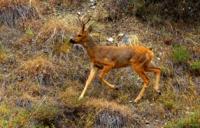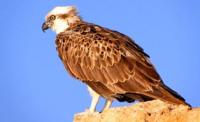You are here
Fauna of Buyratau park.


Ecological tours to Buiratau park.
“The steppe has been blooming for centuries and will not bloom soon.
For centuries, in the mountains, flowers caress the eyes.
Some come into the world, others are carried away by death,
And the steppe is still the same steppe, and the mountains are the same mountains."
Baba Tahir. "Both heaven and earth..." End of X – XI centuries.
Vertebrate fauna of Buyratau park.
Vertebrate fauna of Buyratau park.
The fauna of the natural park Buyratau is distinguished by rare diversity. Mountain, forest and steppe species of animals live here: argali, Siberian roe deer, marmot marmot, steppe ferret, ermine, hare and hare hares, lesser ground squirrel, common hamster, gray and white partridges, common quail, wood pigeon, common turtle dove, shelduck, whooper swan, golden eagle and others.
The fauna of the Buyratau National Park is represented by invertebrates (entomofauna) and 5 classes of vertebrates - Bony fish (Osteichthyes), Amphibians (Amphibia), Reptiles (Reptilia), Birds (Aves) and Mammals (Mammalia).
Invertebrates of Buiratau park.
The absence of a specialist entomologist shows the paucity of information about invertebrates. According to expeditionary collections and a few disparate literary sources on the territory of the Buiratau National Park, approximately 1434 species from 8 orders of insects can be noted, including: dragonflies - 15, orthoptera - 35, homoptera - 221, bugs - 125, beetles - 579, hymenoptera - 209, Diptera - 54, butterflies - 196.
Class Osteichthyes - Bony fish of Buiratau park.
The ichthyofauna of SNNP Buiratau is very poor. This is due to the fact that its territory as a whole is characterized by a greater number of closed basins, mainly with shallow saline and brackish lakes. The largest are Lake Bozaigyr (44 hectares) and Lake Azhbay (55 hectares).
There is no information about the fish of the park's lakes in the literature. At present, the habitat of fish is established only in the lake. Azhbai, in which the water is suitable for the habitat of hydrobionts in terms of chemical composition and content of biogenic elements. In the lake Azhbay is currently inhabited only by silver carp - Carassius quzatus (Linnaeus, 1758) and carp (carp) - cyprinus carpio (Linnaeus, 1758). Crucian carp is a native species, carp is the result of introduction.
Class Amphibia - Amphibians of Buiratau Park.
Amphibians in the SNNP "Buiratau" are represented by two species. These are: green toad - Bufo viridis (Laurenti, 1768) and moor frog - Rona arvalis (Nilsson, 1842). Both species are sporadically distributed. They are found in temporary and permanent reservoirs and on their coasts, in various watercourses and are not numerous everywhere.
Class Reptilia - Reptiles of Buiratau park.
Three species of reptiles were found on the territory of the national park "Buiratau". The agile lizard Lacerta agilis (Linnaeus, 1758) is widespread in forest, forest-steppe, and steppe biotopes, and the steppe viper Vipera ursine (Bonaparte, 1835) also lives there. In wet areas, closer to the water, there is an ordinary snake - Natrix natrix (Linnaeus, 1758). The number of agile lizards in the park is high, the steppe viper and the common viper are already common, but not numerous.
Birds of Buyratau park.
Analysis of literary sources and according to the results of numerous studies, the species composition of birds for the present period of time is 183 species of birds, of which 22 species are Red Book species.
Class Mammalia - Mammals of Buiratau Park.
The taxonomic list of mammals of the SNNP "Buiratau" consists of 55 species, representatives of 6 orders: Insectivora - Order Insectivores, Chiroptera - Order Bats, Carnivora - Order Carnivores, Artiodactyla - Order Artiodactyls, Rodentia - Order Rodents, Lagomorpha - Order Lagomorpha.
Of the mammals listed in the Red Book of the Republic, the park is inhabited by the only species - argali. Also included in the IUCN list are the pond bat (Myotis dasycneme), the stoat (Mustela ermenia), the steppe polecat (Mustela eversmani), the corsac fox (Vulpes corsac), the lynx (Lynx lynx), the steppe mouse (Sicista subtilis), the steppe lemming (Lagurus lagurus) and steppe pika (Ochotona pusilla).
There are no endemics among mammals in the park. Inventory work to identify and clarify the habitat of small mammal species in the park continues.
Geographic coordinates of Buyrytau park (Ereymentau branch): N51°39'59.52" E72°43'09.40"
Geographical coordinates of Buyrytau park (Belodymovsky branch): N51°20'30.91" E73°21'39.10"
Authority:
https://gnpp-buiratau.kz/ru/page/fauna
Photos by
Alexander Petrov.






